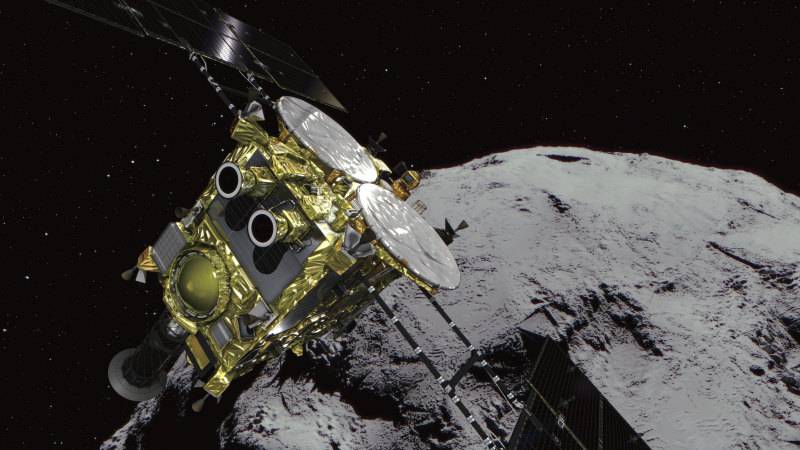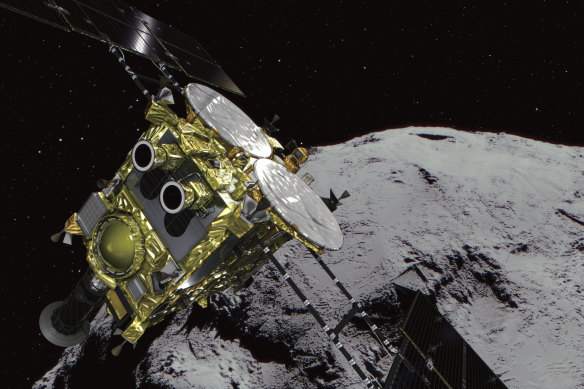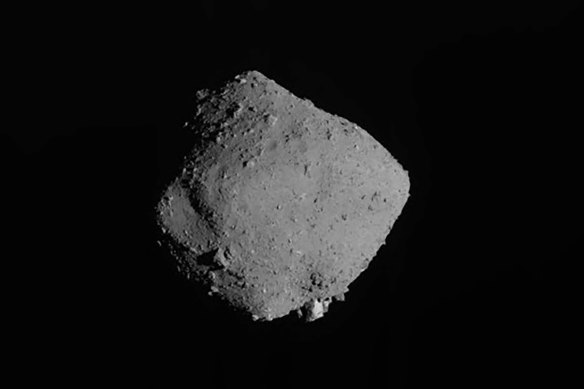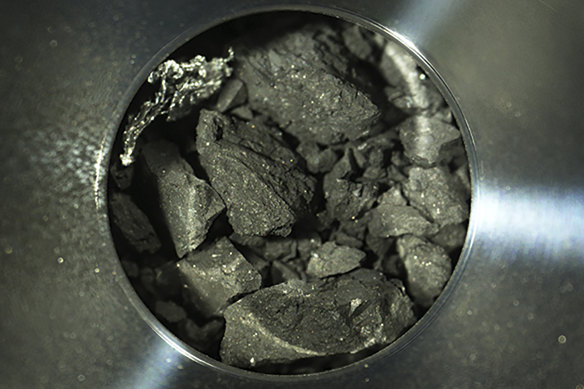Key points
- Samples returned by a robotic probe from the asteroid Ryugu have tested positive for uracil – a component of RNA, the precursor to DNA.
- Other DNA building blocks have been found on meteorites that struck Earth, including one that fell near the Victorian town of Murchison in 1969.
- A previous mission to an asteroid revealed evidence the space rocks also carry water.
The molecular building blocks for the genetic material probably used by the first life on Earth may have been delivered to us from deep space by meteorites.
A Japanese team revealed their discovery in Nature Communications on Wednesday, in news one Australian scientist said could be key to understanding the origins of life.
Hayabusa2 fired a projectile into the asteroid Ryugu, blasting rock from the surface to be collected.Credit:JAXA / Supplied
Samples returned by a robotic probe from the asteroid Ryugu tested positive for uracil – a component of RNA, the precursor to DNA – as well as vitamin B3.
The find also suggests, tantalisingly, that all the ingredients for life – including water – can be found in deep space.
How life first arose on Earth remains a fundamental scientific mystery, with DNA and its precursor right at the heart.
To first create life, you probably need a molecule that can create chemical reactions, record information and copy itself. RNA, which can do all those things, is the prime suspect.
The asteroid Ryugu in a photo taken by Japanese probe Hayabusa2.Credit:JAXA / Supplied
But RNA is made of unusual molecules not readily found on Earth. Where do they come from?
There are three leading theories: at the bottom of the ocean; in shallow pools on the surface; or in deep space.
In the depths of the Earth’s oceans lie hot-water-spewing hydrothermal vents. There is some evidence they may be able to form the molecules needed for RNA. Warm, shallow pools that were constantly drying out and refilling might also give rise to the molecules.
Professor Trevor Ireland, a University of Queensland cosmochemist who has studied samples from Ryugu but was not involved in the Japanese study, said the deep-space theory relied on the unusual power of cosmic rays – high-energy radiation from outside our solar system.
An optical microscope image of soil samples in a capsule brought back by Hayabusa2Credit:JAXA / Supplied
When it hit simple carbon or oxygen atoms on asteroids, the radiation could transform them into unusual new molecules, including those that made up RNA, he said.
“This is key to understanding where life is actually coming from,” he said of the Japanese discovery.
“This gives you the seeds you could use to build life up. And there’s a lot of this material potentially falling down to Earth.”
To get answers, space probe Hayabusa2 was launched from Tanegashima Space Centre in 2014, arriving at Ryugu four years later. The probe fired a projectile into the asteroid, blasting rock from the surface, which it collected.
The probe then returned to Earth to deposit its samples. After a fiery journey through the atmosphere, it landed at Woomera in the Australian outback.
The spacecraft gathered just a teaspoon of black gravel from the asteroid, but it was enough.
Other DNA building blocks have been found on meteorites that struck Earth, including one that fell near the Victorian town of Murchison in 1969. Finding the same molecules on an asteroid in deep space confirms their extraterrestrial origins.
An earlier Japanese mission to an asteroid revealed evidence the space rocks also carry water. That means both water and organic molecules are probably spread out through space – just waiting to find a planet to fall on.
“You’ve got all these ingredients throughout the galaxy. It’s just a matter of finding that little blue speck in the universe that has the right condition to support liquid water. And then a miracle occurs and you get life,” said Ireland.
But the finding on Ryugu doesn’t seem likely to end the debate on life’s origins.
Could the delicate organic molecules on asteroids survive the flight through Earth’s early atmosphere? For much of its early history, the Earth was hot and barren – could the molecules survive that?
“Is it straight from space, delivered on a plate, here you go? Or do the asteroids that bombard Earth all get cooked?,” asked Curtin University planetary scientist Professor Fred Jourdan.
Could the truth be as simple as both answers being right?
“It’s very likely uracil was being made on early Earth anyway,” said Dr Albert Fahrenbach, director of the Australian Centre for Astrobiology. “If I had to put my money on it, I would say both sources were delivering it.”
Liam Mannix’s Examine newsletter explains and analyses science with a rigorous focus on the evidence. Sign up to get it each week.
Most Viewed in National
From our partners
Source: Read Full Article








